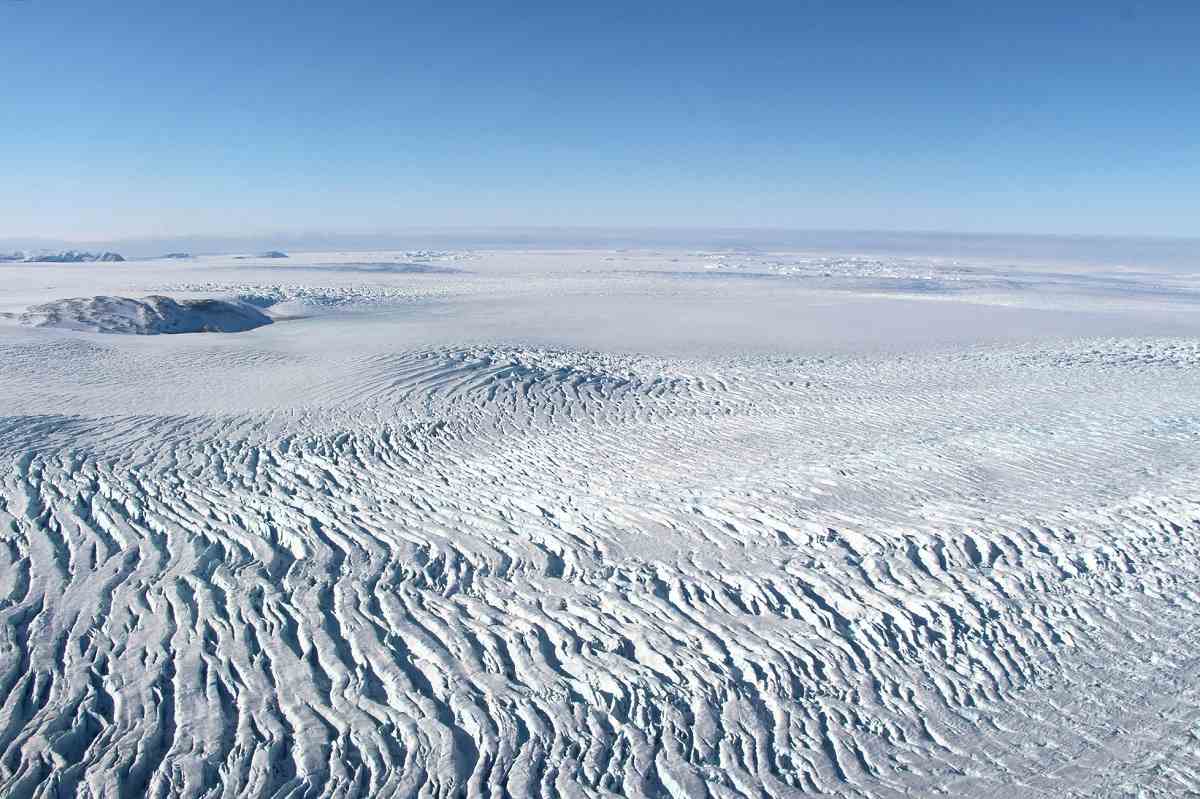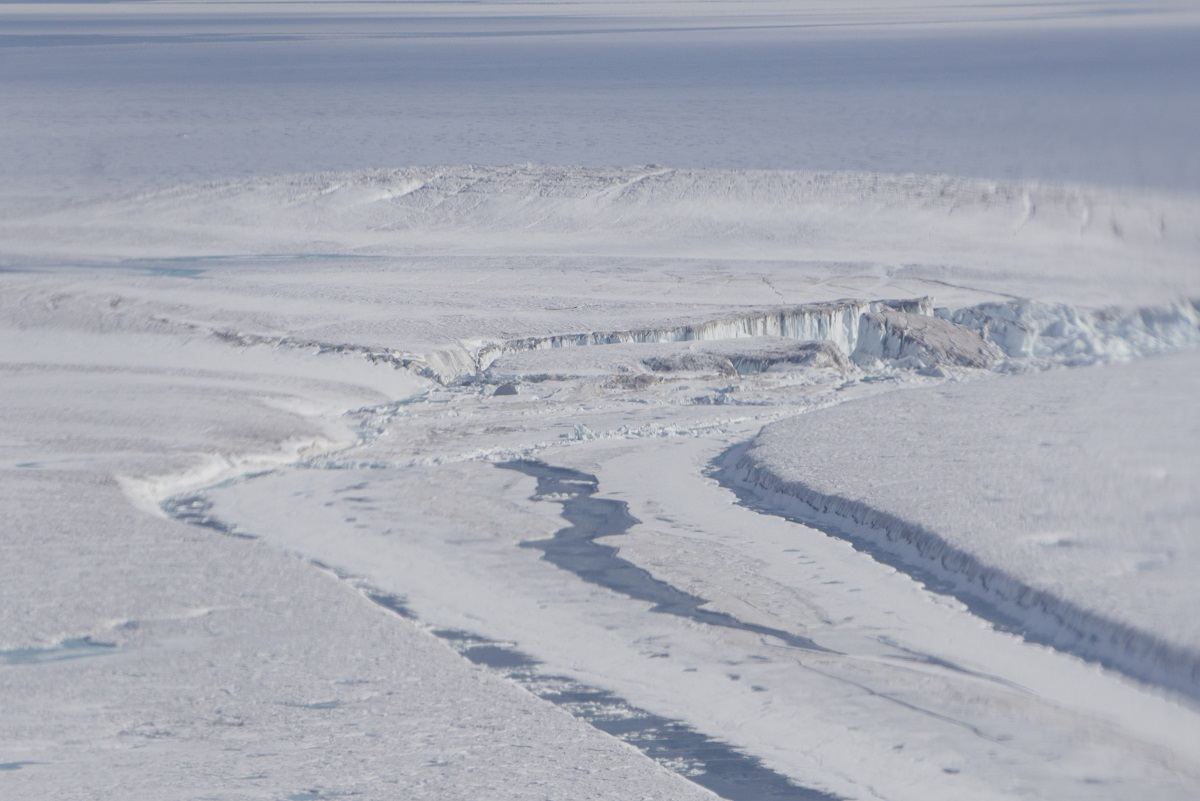
Photo taken during scientists and crew with NASA’s Operation IceBridge surveys of northern Greenland’s Ryder Glacier. This shows heavy crevassing near the coast of Melville Bay in west Greenland.
12:26 JST, November 8, 2023
The vast floating ice platforms of northern Greenland, unrivaled features of the northern hemisphere that keep our seas lower by holding back many trillion tons of ice, are in stark decline, according to new scientific research published Tuesday.
These northern Greenland ice shelves, as they are called, have lost 35 percent of their overall volume since 1978, the research published in “Nature Communications” found. That’s equivalent to a loss of roughly 400 billion tons of floating ice that acted like the stopper of a decanter, preventing glaciers from flowing into the sea and accelerating sea level rise.
And now there are only five large shelves left, stretching out from their fjords toward the Greenland Sea and the Arctic Ocean. That includes three major ones – Petermann, Ryder and Nioghalvfjerdsbrae (often referred to as 79 North for its location in degrees Latitude) – whose respective glaciers could ultimately account for 3.6 feet of sea level rise if they were to melt entirely – a process that would take centuries to play out.
“Those are the last remaining ice shelves of the ice sheet,” said Romain Millan, the lead author of the study in Nature Communications and a scientist at the Université Grenoble Alpes in France. “All the other ones have collapsed or retreated.”
Overall, losses of ice from Greenland have caused about 17 percent of observed sea level rise globally between the years 2006 and 2018. But it could get worse from here.
If Greenland’s five remaining ice shelves shatter, it would not only mean much faster sea level rise, but also that only the southern hemisphere would continue to feature major ice shelves. Across Antarctica, many glaciers still boast these large floating extensions, which can be the sizes of cities or even states and, in a few cases, countries.
While the globe currently contains huge ice sheets in both hemispheres, the latest news – delivered during a year of record global heat – further underscores that Greenland’s ice sheet has been deeply compromised by planetary warming, with potentially grave future implications.
“We are heading toward an ice shelf free northern hemisphere,” Millan said.
Scientists based at institutions in France, the United States and Denmark contributed to the new research, which used satellite data, ocean observations and climate modeling to measure the change in the Arctic ice shelves’ spatial area and thickness. They also evaluated where the shelves come aground on the sea floor, called the grounding line. This area, where the floating shelf ends and the grounded glacier begins, is retreating inland across nearly all of the shelves – a key sign of weakening – as warm ocean waters melt them from below.
“The implications of these findings are profound, as they reveal a direct connection between ice shelf changes and the dynamics of Greenland’s glaciers,” said Stef Lhermitte, a scientist specializing in satellite observations of glaciers at the Delft University of Technology in the Netherlands who was not involved in the current study. “The retreat of grounding lines and increased ice discharge are clear signs of a weakening ice shelf system.”
Take the 79 North ice shelf, Greenland’s largest, around 300 feet thick at its edges where it flows outward to both the north and east into the Greenland Sea. Here lies the exit point for over 6 percent of all Greenland’s ice, the equivalent of nearly two feet of potential sea level rise.
And 79 North once had a twin, a companion shelf named Zachariæ Isstrøm. Together they comprised the seaward endpoint of a unique feature called the Northeast Greenland Ice Stream, a nearly 400 mile long and 25 mile wide river of ice that flows toward the coast. Recent research suggests this could be a particularly vulnerable sector in the ice sheet.

View from a helicopter of a crack in the 79 North ice shelf, with the iceberg that would later form on the right-hand side of the image.
Between 2003 and 2012, the floating section of Zachariæ Isstrøm came apart. It lost 105 billion tons of mass and the glacier, now largely uninhibited, sped up its flow into the ocean, to whose rise it now contributes 18 billion tons of ice per year according to Millan. (It takes 360 billion tons to raise global sea levels by a millimeter).
Two other smaller northern Greenland ice shelves also shattered in the first decade of the 2000s – showing that the loss of ice shelves is reaching the highest, coldest latitudes of the ice sheet.
No wonder that all eyes are now on Petermann, Ryder, and especially 79 North.
The Washington Post visited Petermann in 2016 and witnessed rain atop the shelf, which intensified the already wet conditions atop the ice and led to cascading runoff. More recently, scientists documented a worrying process that could be accelerating the glacier’s melt – the entire ice shelf lifts and falls with the tides and as it does, ever-warmer Atlantic water flows in beneath it, carving large open spaces beneath the glacier. This may help explain why Petermann’s grounding line has retreated rapidly inland in recent years toward the center of Greenland.
The deepest worry about Petermann is that the glacier actually lies at the seaward end of a deep sub-ice canyon, one that ultimately could allow the ocean to penetrate into the center of the Greenland ice sheet. The first step in this process would be the removal of the Petermann ice shelf.
Ryder, meanwhile, has shown the farthest backward grounding line retreat of any northern Greenland glacier that still boasts an ice shelf. The exceedingly remote glacier, whose ice flows outward toward the North Pole, has seen its grounding line retreat over five miles inland along the seafloor since 1992, the new research found. Ryder alone has the potential to raise sea levels by about 5 inches worldwide, were it to be lost entirely.
And then there is 79 North, Greenland’s largest, where there is even more at stake.
For some time, this shelf had appeared quite stable. That’s in part because, on its eastern side, it sits anchored atop several small islands. These points are sometimes called “ice rises” because they appear as visible high points as the islands push up under the ice. Scientists also sometimes refer to them as “pinning points.”
“79 North, I thought for a long time, it’s really hard to kill it,” said Angelika Humbert, a researcher with the Alfred Wegener Institute in Germany who has led several field campaigns and studies related to the glacier.
But the picture is changing. Warm Atlantic water has recently been measured reaching the base of 79 North and appears to have carved a deep channel into the underside of the ice shelf near the glacier’s grounding line.
And then there’s this image, which Humbert sent The Post over the summer. It shows that a large iceberg, nearly eight square miles in size, has broken off from the end of 79 North. In a recent paper in the journal the Cryosphere, Humbert and colleagues not only predicted the break, but argue that current changes at 79 North suggest that the glacier is “potentially at the onset of a major retreat phase.”
The pattern of cracking seen here is different than prior situations in which 79 North has released icebergs. These bergs used to form further out toward the sea, and the cracks would run laterally across the front of the glacier, rather than pointing inward toward its center, as the current ones do.
The next thing to watch, Humbert said, is the region that the scientists label an “ice bridge” in the image above – it connects the floating glacier to the rocky fjord wall along its southern boundary. The researchers fear that this could be the next part of 79 North to be compromised.
If this all plays out as their study predicts, then it means that with fewer pinning points holding it back, 79 North would speed up its flow to the sea. “This is a big glacier, and with an acceleration of this glacier, you would be able to increase the sea level rise significantly,” Humbert said.
“The next major outlet glacier in Greenland is also prone to collapse, and this will add to [the] growing increase in global sea level rise,” added Nicolaj Larsen, a researcher at the University of Copenhagen in Denmark who has published on the vulnerability of the Northeast Greenland Ice Stream, in a comment on Humbert’s paper.
Humbert does have one disagreement with the latest study, though. She said by email that a recent spate of ocean cooling between 2017 and 2020 had at least temporarily slowed the melt at 79 North, something the new research “should have recognised.”
“The overall picture of retreat is right,” Humbert added.
That picture is indeed a concerning one.
“Human actions are still critically important for the long-term future of the Greenland Ice Sheet – and what that means for sea levels at our coasts – but the warming that is already locked in from our past behaviors will continue to cause ice loss over coming decades,” said Twila Moon, an expert on Greenland at the National Snow and Ice Data Center in Boulder, Colo., who was not involved in the latest study.
“Sadly, that also means continued disintegration and weakening for the remaining Greenland ice shelves,” Moon said.
"News Services" POPULAR ARTICLE
-

American Playwright Jeremy O. Harris Arrested in Japan on Alleged Drug Smuggling
-

Japan’s Nikkei Stock Average as JGB Yields, Yen Rise on Rate-Hike Bets
-

Japan’s Nikkei Stock Average Licks Wounds after Selloff Sparked by BOJ Hike Bets (UPDATE 1)
-

Japanese Bond Yields Zoom, Stocks Slide as Rate Hike Looms
-

Japan’s Nikkei Stock Average Buoyed by Stable Yen; SoftBank’s Slide Caps Gains (UPDATE 1)
JN ACCESS RANKING
-

Keidanren Chairman Yoshinobu Tsutsui Visits Kashiwazaki-Kariwa Nuclear Power Plant; Inspects New Emergency Safety System
-

Imports of Rare Earths from China Facing Delays, May Be Caused by Deterioration of Japan-China Relations
-

University of Tokyo Professor Discusses Japanese Economic Security in Interview Ahead of Forum
-

Japan Pulls out of Vietnam Nuclear Project, Complicating Hanoi’s Power Plans
-

Govt Aims to Expand NISA Program Lineup, Abolish Age Restriction























